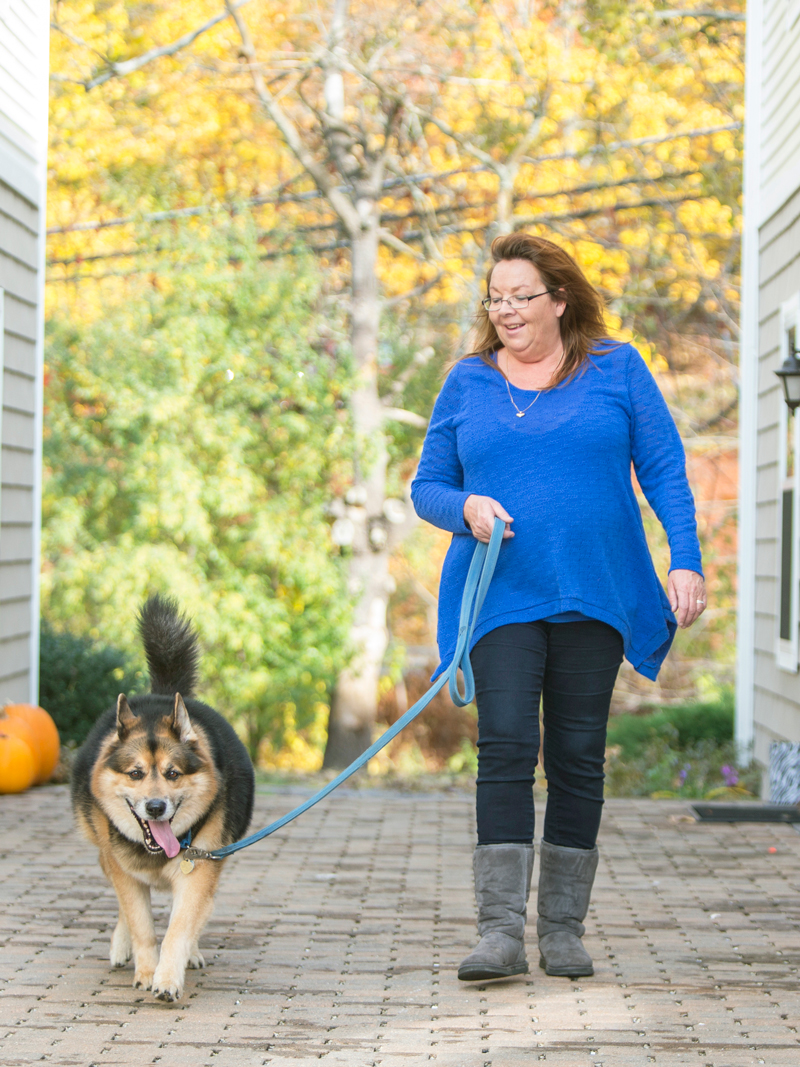Home is where your pets are welcome
A Humane World campaign pushes for less restrictive pet policies in rental housing

Finding a place to rent with her big dog was harder than Mary Jane Kiro thought.
It was 2011, and Kiro was losing her home in Goffstown, N.H., to foreclosure, after her nerve disorder prevented her from working full time.
She had a beloved German shepherd-Siberian husky mix, Bandit, who helped her stay healthy and functional—to combat her disorder, she needs to walk frequently if she wants to be able to keep walking at all. Having a dog like Bandit, who needs plenty of exercise and regular walks, helped her do just that.
But after months of looking, she found no apartment that would welcome the 127-pound half-German shepherd, despite his friendly and playful nature.
Not only had Kiro lost her livelihood to a debilitating condition, but now she was losing her house and faced the prospect of choosing between a home and her pet—an animal who was not just a family member, but essential to her health and daily life.
“It was a devastating thing,” says Kiro, adding that she mistakenly figured, “Oh, all these places are scurrying to let dogs move in.”
‘Pet-Friendly’ Isn’t Always That Friendly
Kiro’s difficulty isn’t rare. Many apartments that consider themselves “pet-friendly” have banned-breed lists and weight restrictions, and some even require unreasonable conditions of occupancy such as the declawing of cats. Some landlords won’t allow pets at all, basing their policies on preconceived notions that pets damage property more than human residents. As a result, housing troubles are one of the top reasons that owners surrender pets to shelters each year, according to HSUS estimates.

In response, The HSUS launched the Pets Are Welcome campaign in September. Campaign staff work with private and public housing operators, encouraging them to implement pet policies without breed or weight restrictions, remove other unreasonable restrictions and actively welcome residents with pets.
“No one should have to choose between their home or their pet,” says Cory Smith, HSUS director of pet protection and policy. And people who want to adopt shouldn’t be prevented from doing so by a lack of housing options.
In 2014, 72 percent of renters surveyed by Apartments.com said they have pets. However, many properties still have strict rules that make it difficult for pet owners to find rental housing.
“It’s hard to find an apartment complex that doesn’t advertise as ‘pet-friendly,’ but they commonly ban dog breeds and have strict limits on weight and number of pets, which isn’t friendly at all,” says KC Theisen, HSUS director of pet care issues.
Under its new campaign, The HSUS will celebrate any property that implements “Pets Are Welcome” policies, which include reasonable pet fees, no breed or weight restrictions and more. The Pets Are Welcome tag differentiates apartments from being merely “pet-friendly”—an “overused cliché with little meaning in the housing industry,” says Theisen. Sometimes, “the pet policy has been in place so long—it’s so entrenched—that nobody really knows where it came from or why it exists anymore,” she says.
In many cases, breed restrictions are based on the false idea that certain breeds are inherently aggressive.
“This idea is so strongly established in the housing and insurance industries that the use of terms like ‘aggressive breed’ is prevalent even in legal documents,” says Smith. “Even though the notion is rejected by experts in animal behavior and genetics, public health and policy, it has gone unchallenged in the world of ‘pet-friendly’ housing.”
So, Pets Are Welcome will work with insurance carriers, as well as housing operators, to rethink their screening of dog owners and promote breed-neutral policies.
Companies have been enthusiastic about discussing their policies. The HSUS has identified companies that already have strong policies in place. Other properties that still have restrictive policies are open to change; they’ve just never been questioned about their policies, says Theisen. They don’t always realize there is a demand for more open policies or how better policies will benefit their bottom line and keep residents and pets together, she says.
In New Hampshire, Twin Ponds at Nashua has had open pet policies since before manager Deb Palmer started working there about 17 years ago. With about 400 units and more than 300 dogs, Twin Ponds has never had problems that would make it reconsider the kinds of dogs allowed, says Palmer.
“I get very upset when I hear about all these so-called [aggressive] breeds that don’t have homes, because they should have homes,” she says. “Bring ’em here, we’ll take ’em.”
Twin Ponds has two dog parks, a pond dogs can swim in (if they are on a leash), a monthly dog photo contest and an annual event that involves various dog activities, like one year’s dog-and-owner lookalike contest. There are no breed or weight restrictions. All breeds require a liability policy, which is part of standard renters insurance, Palmer says.
To deal with the most common pet-related concerns property managers have, the Pets Are Welcome campaign provides pet care resources for renters and information for landlords on issues such as setting expectations for residents with pets, solving litter box problems, successfully renting with pets and ensuring residents clean up after their dogs.
Crossing All Barriers
Staff of the Humane World Pets for Life (PFL) program, which focuses on bringing pet care resources to underserved communities, see the consequences of housing issues regularly.
“Housing crosses all barriers. It affects people from all socioeconomic backgrounds,” says Kenny Lamberti, former PFL program manager. “But everything that hits the rest of society just hits the people who are living in underserved communities harder.”

In PFL communities with public housing, it’s common that a landlord or letter in the mail will suddenly inform residents that they can’t have a pet. In some cases, these out-of-the-blue purges aren’t even aligned with the policies of the building or the law, but residents don’t know that and are scared to lose their homes. They often have nowhere else to go, so they give up their pet.
Lamberti recalls a Philadelphia PFL client who lived in public housing with her two children and suddenly received a letter stating she couldn’t have more than one pet. She had three cats whom she and her kids loved, but her “knee-jerk reaction” was to bring the pets to the shelter.
With Lamberti’s help, she talked to the landlord and was able to keep her cats. She got them back from the shelter the same day. “She was scared to advocate for herself, because she thought if she talked to [the landlord] at all, she’d get kicked out,” he says. “It was a perfect example that when you live in poverty and you’re underserved, fear motivates a lot of your choices.”
To prevent similar surrenders—and make adopting a pet an option for more renters who don’t already have one—shelter employees can reach out to property owners and advocacy groups.
If a family decides to surrender a pet because their landlord threatened them with eviction, shelter workers can share their knowledge that the only way someone can be evicted is through a legal eviction process, which can take time—weeks or months in some cases. Shelter staff can mitigate their fear and encourage the family to explore other options, like talking with the landlord or getting legal assistance to try to keep their pet and their home. Shelters can provide owners with tools and services to resolve nuisance complaints and other pet-related problems that lead to conflict with their housing providers.
Smith is optimistic that in addition to being influenced by making a profit from attracting renters who have pets, housing operators will be moved by the positive impact they can have on families and communities by becoming Pets Are Welcome. “They don’t know their policies are hurting,” she says. “Once there is more awareness, there will be progress.”
As more properties become Pets Are Welcome, more homes will be available for shelter animals, and more families will be kept together—just like Mary Jane Kiro and Bandit, who found a home at Twin Ponds.
After a few months of looking, Kiro was losing hope, until she happened to be driving her son’s friend home to Twin Ponds and saw a sign hanging up that said, “We love all dogs.”
Four years later, she and 8-year-old Bandit are still there.
“I searched and searched and begged and pleaded … to find a place to live, and I had such a hard time,” says Kiro. “The day that I pulled in there and [saw the sign] was probably the happiest day of my life.”







